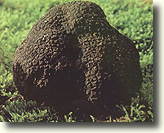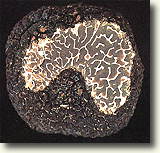
A perfect truffle should be firm, have a good aroma and full of taste. It breathes and absorbs oxygen and rejects carbon dioxide and other gases containing its aroma. After a while it oxidates and loses its aroma. It is this clear that once ripe, it should be eaten as soon as possible, whence the need to buy straight from the market, or from retailers with recent supplies.
The Truffe noire du Périgord fresh and grated improves everything that is in contact with it. It goes very well with celery, shallots, and well reduced sweet onions, artichokes, avocados, jerusalem artichokes.
It is important to trap its aroma, either in fats such as oil, butter, cream, or by infusion in a sauce or it should be added at the end of cooking, or enclosed in puff pastry, brioche, bread, or in slivers under the skin of poultry.
The best Brumales can be used in sauces. Aestivum is only used grated pasta and risotto.
The Varieties Harvested
...and their gastronomic value
Tuber Melanosporum

Called the black truffle of Périgord, it is harvested between November and March.
Epidermis wartish brown with red reflections Soil marbled with white on anthracite base colour. Smells of forest undergrowth and damp earth, roasted dry fruits.
Taste: finely peppered, recalling its aromatic composition, long in the mouth. Only admitted in Grade 1; Ste Alvère.
 Tuber Brumale Harvested between November and March, on the same sites as Mélano which it strongly rivals.
Tuber Brumale Harvested between November and March, on the same sites as Mélano which it strongly rivals.Darker epidermis, flaking off easily. Soil less subtly marbled with a grey background. Smells of turnip, nuancée with garlic (suavum version) ethereal, disagreeable (version moschatu).
Taste: Very peppery and characteristically turnipy, relegated to Grade 2 Ste Alvère.
Tuber Aestivum
 Harvested between May and September sometimes later..
Harvested between May and September sometimes later..Epidermis dark brown, large pyramid-shaped wartlike deformations, striped in both directions. Soil: finely marbled with branches on a white background, veering towards grey matures well.
Subtle smell of underwood.
Taste of forest mushrooms.

Tuber Uncinatum
Called "Bourgogne", closely related to the previous, quite rare in Dordogne.
The best season is between September and December. Same visual aspect, soil; chocolate, smell and taste more pronounced.
...And a story on truffles cannot be complete without a recipe!
Here is a traditional recipe for scrambled eggs with truffles -- an easy recipe for anyone -- and importantly, if you have never tasted truffles and do not have ready access to fresh truffles, you can use a good truffle oil from your grocer or deli and then you, too, can experience the taste that have made kings and emperors dream since the beginning of time!
SCRAMBLED EGGS WITH TRUFFLES
Ingredients for 4 persons :
8 very fresh eggs
80 g of butter
80 g fresh truffles*
2 spoonfull of thick fresh cream (or if you must-- creme fraiche)
salt & pepper
Put into a pan whith a thick bottom and well heated before, 50 g of melted butter, 8 slightly whipped eggs and 80 g of roughly chopped truffles.* Season with salt and pepper.
Cook the eggs on a low fire or in a "bain-marie" and continuosly turn with a wooden spatula. Remove well from the edges of the pan the clotted parts of the eggs. The cooking must be done very slowly.
When the mixture is smooth, slighthy thickened and without lumps, remove the pan from the fire.
While you continue to turn the eggs with the wooden spatula, add 30 g of butter and 2 spoonfull of the thick fresh cream or creme fraiche.
Serve with fresh crusty French bread.
* If you do not have fresh truffles, substitute with one large tablespoon of truffle oil.
Click on Link:
Click on Link:
Chateau Lalinde : The perfect venue for your event
TAGS: Dordogne Rent a chateau France
Chateau
Truffles Food Holidays in France Recipes







